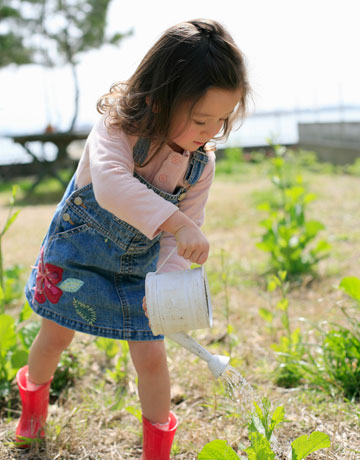Stimulate the Five Senses through Your Garden
Submitted by Jackie Edwards, Guest Blogger
“Why try to explain miracles to your kids when you can just have them plant a garden” (Robert Brault).
 |
| Image courtesy of www.blogthecoast.com |
Gardening provides many miraculous benefits for a child’s development including fine motor skills, math skills, responsibility, and science. Children that spend time outside are also happier as the landscape helps to reduce stress, lower blood pressure, and increase attention. When combining gardening with the use of all senses, you can further increase the benefits.
A sensory garden is designed to stimulate all five senses. Multi-sensory environments impact brain development and are therefore extremely beneficial for kids with sensory processing disorders caused by autism, brain injuries, and premature birth. It can be therapeutic and a gentle way to explore their senses. They can either focus on one sense or tackle multiple areas at once. For children who don’t have sensory processing disorders, a sensory garden can help improve concentration, alertness, memory, mobilization skills, and communication. This environment stimulates learning and provides a foundation so that children can succeed later in life. As parents, this is all we want for our kids, right?
So here are some steps to help you create the perfect sensory garden.
Decide on Space
 |
| Photo By Dylan Duver, Flickr |
Your sensory garden can range from a small box to your entire backyard. However, you should take some things into consideration when deciding on how big your garden will be.
- Consider your child’s needs. Take the age of your child into consideration. Younger kids may want to start with a smaller garden so that they are not easily distracted. Also, if your child is in a wheelchair, you may want a bigger area with more open paths and less slopes and corners so that he or she can navigate and fully experience the garden.
- Consider maintenance. Remember that you do have to maintain the garden. Nothing’s worse than an unloved space so be sure you pick a size that is manageable for you based on your schedule and commitments.
- Raised planters can be great for gardens because it reduces the amount of maintenance for you as you don’t have to dig into the ground. However, be sure to find a planter that is the right height for your child. He or she will still need to be able to see and feel the plants.
Adding the Senses
When planting your garden, be sure that you add stimuli that represents all five senses. Here are some suggestions to incorporate each sense.
- Sight: Visual presentation is the most important element of a sensory garden. This is because science has shown that simply viewing green spaces can have direct benefits to your child such as reduced stress, increased attention, and lower blood pressure. In turn, this can boost his or her immune system and reduce risks of diseases. Therefore, it is important to have as much green space as possible in your garden. You should also plant flowers of varying colors. Try red and yellow flowers as red colors promote learning and yellow increases attention and mental activity. Planting nectar producing flowers can also attract bees and butterflies, which will add even more sights.
- Touch: Kids are no stranger to touch. It’s how you learn what things are. Touch can be incorporated into a garden through plants as well as ground surfaces. Plants have different feels and it is important to vary these feelings throughout the garden. Some plants can be hairy, while others are smooth. Pebbles, gravel, bricks, and pavement are also great additions to a garden because children can touch these with their hands or even walk across them with their feet. You can also vary the level of shade so that your kid will feel the sun’s rays in some areas and the cool shade in others.
 |
| Photo by michael podger on Unsplash |
 |
| Photo by Nine Köpfer on Unsplash |
- Smell: Our smell is one of the strongest senses and can directly influence brain activity. Our sense of smell is tied to the limbic system which connects the brain parts associated with learning and emotional processing. Find flowers that produce strong fragrances and you will switch this part of the brain on.
- Hearing: Sounds can be hard to add to a garden. One great way to bring out aspects of hearing is to add water such as a small garden fountain or pebble pool. This will add the sound of rushing water, and attract birds to your garden which will chirp and add beautiful music. You can also install wind chimes around the garden to further increase the level of sound.
- Taste: Children are always putting things in their mouth, so provide plants that are edible to stimulate the sense of taste. Plant herbs, fruits, and vegetables in your garden. They are not only tasty, but can teach your child about healthy eating. Also plant edible flowers such as violets and nasturtiums.
Jackie Edwards works as an editor, researcher and writer in Reno, Nevada. Both she and her husband are keen environmentalists. With their two young daughters as eager and active participants, they like to spend family time working in their local area helping with everything from recycling, picking up litter, to promoting wildlife conservation.


